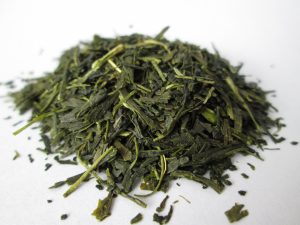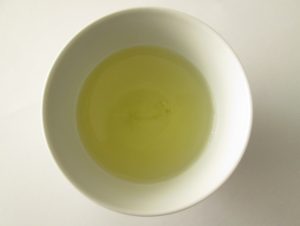 I received this sencha sample from Hidenori Moriguchi of MITE.
I received this sencha sample from Hidenori Moriguchi of MITE.
This company sells tea from Mie prefecture, and is just starting to reach out to the global market.
Made in the Misugi area of the city of Tsu, this premium sencha has dark colored leaves which are finely rolled.
The leaf aroma is slightly vegetal and creamy, it’s definitely not your average sencha.
Shall we give it a try?
 Brewing it with the standard technique of 1 teaspoon of leaves, 60 ml of water at 70ºC (158ºF) for 1 minute, we get a liquid that’s light yellow with a greenish hue.
Brewing it with the standard technique of 1 teaspoon of leaves, 60 ml of water at 70ºC (158ºF) for 1 minute, we get a liquid that’s light yellow with a greenish hue.
Before the first sip, it I smelled the tea. It has a faint, grassy aroma.
Flavor-wise, it’s quite good. I didn’t find any noticeable bitterness, and the astringency is toned down.
This tea might be good for beginners, since it doesn’t have the characteristic seaweed-like flavor. It’s quite easy to drink, even the aftertaste is gentle.
The second infusion was also pleasant, I had no problems with it.
My opinion is that this is a good green tea, with a straightforward taste. If you find that green teas are generally too strong for you, this might be a good choice.

June 18, 2014
You are really professional. The description of your comment is very easy to understand for all Japanese green tea fans.
June 18, 2014
Hi Hidenori
I’m glad you liked the review. Thanks for the sample : )
June 18, 2014
Any idea about which cultivar? Had met some farmers in Mie ken and few of them were experimenting with various cultivars and organic practices. I am sure this is not from them but it would be interesting to know the cultivars used.
June 20, 2014
Thank you for your inquiry. This cultivar is “Yabukita”. But to decide each quality of Sencha is also considerably depending on yealry average temparature, temperature difference between day and night, sunshine time, land conditions, climate and also difference appears by the fertilizer, and one more, who produces.
June 22, 2014
確かに!森口さん、ありがとうございました。 Indeed! Thank you Moriguchi san.
June 24, 2014
I found this to be one of your most interesting posts, but the only way to reach them, for me, in this country, seems to be on facebook.
I love that they are generational tea farmers who continue to do their best in a changing world, to maintain their standards and produce a quality product. That kind of pride and integrity that I also see in Obubu.
Keep up the good work Ricardo. I hope the people at MITE become successful beyond their dreams.
June 24, 2014
Thank you for your kind comment. Currently MîTÉ is under developing and by the end of September in this year, MîTÉ can provide you more informtion via their website. Yes, with some of MîTÉ producers we are working to improve our quality and but at the same time try to do something new for future Japanese green tea item.
June 24, 2014
Thank you Moriguchi san.
When it involves tea, I will always be a student.
It seems to change from sip to sip and is both complex and simple at the same time.